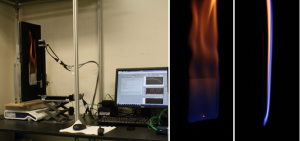New Article Published in Combustion and Flame
Our paper on Estimation of local mass burning rates for steady laminar boundary layer diffusion flames was recently published in Combustion and Flame. This is an extension of our previous work by Ajay Singh and Michael Gollner on estimating local mass fluxes which recently won the Distinguished Paper Award at the 35th International Symposium on Combustion for the Fire Science Colloquium. The paper includes supplementary material, including all of our local measurements and calculations.
Abstract
A unique methodology has been used for the estimation of local mass burning rates and flame heat fluxes over a laminar boundary layer diffusion flame with a high accuracy by utilizing micro thermocouple measurements in the gas phase close to the condensed phase surface. Both liquid and solid fuels were investigated. Convective and radiative heat feedback from the flames were measured both in the pyrolysis and plume regions by using temperature gradients near the wall. As expected, for small laminar flames, convective heating was found to be the dominant mode of heat transfer to the condensed fuel surface and accounted for nearly 85–90% of the total flame heat flux in both liquid and solid fuels. The total average incident flux to the condensed fuel surface was estimated to be approximately 22, 20 and 27 kW/m2 for methanol, ethanol and Poly Methyl Methacrylate (PMMA) wall-bounded flames, respectively. The average convective heat flux from the flame to the wall in the pyrolysis zone was estimated to be 18.9, 17 and 22.9 kW/m2 for methanol, ethanol and PMMA, respectively. The radiative component in these small flames was observed to be small, never accounting for more than 20% of the total wall heat flux. Temperature gradients normal to the wall, proportional to the dominant convective heat flux, were found to decrease from the leading edge towards the trailing edge in the pyrolysis zone, however they were found to remain relatively constant in the combusting plume region (∼450 K/mm) until the tip of the flame was reached. Thereafter, they were found to decrease significantly downstream of the combusting plume. The work presented here also discusses the selection of transport properties at appropriate temperatures to calculate convective fluxes by using a crude approximation as opposed to detailed temperature measurements in such flames.
default

